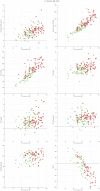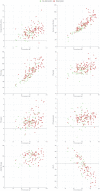Physiological health indexes predict deterioration and mortality in patients with COVID-19: a comparative study
- PMID: 35213841
- PMCID: PMC8908924
- DOI: 10.18632/aging.203915
Physiological health indexes predict deterioration and mortality in patients with COVID-19: a comparative study
Abstract
Old age is a crucial risk factor for severe coronavirus disease 2019 (COVID-19), with serious or fatal outcomes disproportionately affecting older adults compared with the rest of the population. We proposed that the physiological health status and biological age, beyond the chronological age itself, could be the driving trends affecting COVID-19 severity and mortality. A total of 155 participants hospitalized with confirmed COVID-19 aged 26-94 years were recruited for the study. Four different physiological summary indices were calculated: Klemera and Doubal's biological age, PhenoAge, physiological dysregulation (PD; globally and in specific systems), and integrated albunemia. All of these indices significantly predicted the risk of death (p < 0.01) after adjusting for chronological age and sex. In all models, men were 2.4-4.4-times more likely to die than women. The global PD was shown to be a good predictor of deterioration, with the odds of deterioration increasing by 41.7% per 0.5-unit increase in the global PD. As for death, the odds also increased by 68.3% per 0.5-unit increase in the global PD. Our results are partly attributed to common chronic diseases that aggravate COVID-19, but they also suggest that the underlying physiological state could capture vulnerability to severe COVID-19 and serve as a tool for prognosis that would, in turn, help inpatient management.
Keywords: COVID-19; COVID-19 outcome; COVID-19 prognosis; SARS-CoV-2; biological age; pandemic.
Conflict of interest statement
Figures





References
-
- Pranata R, Henrina J, Lim MA, Lawrensia S, Yonas E, Vania R, Huang I, Lukito AA, Suastika K, Kuswardhani RA, Setiati S. Clinical frailty scale and mortality in COVID-19: A systematic review and dose-response meta-analysis. Arch Gerontol Geriatr. 2021; 93:104324. 10.1016/j.archger.2020.104324 - DOI - PMC - PubMed
Publication types
MeSH terms
LinkOut - more resources
Full Text Sources
Medical
Research Materials
Miscellaneous

